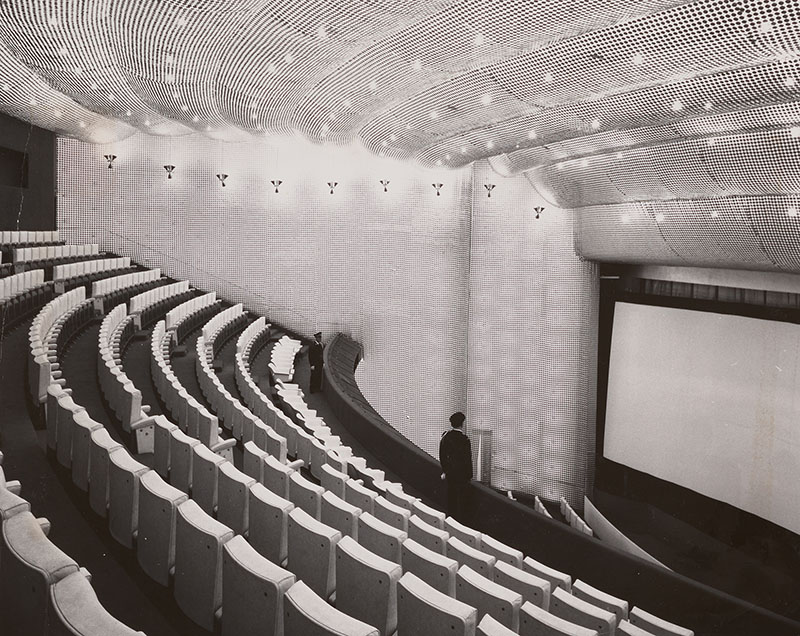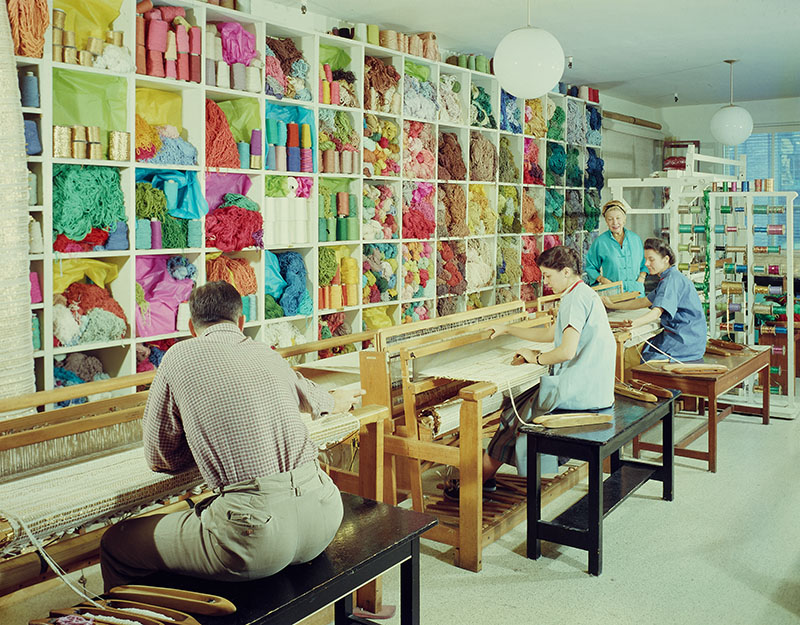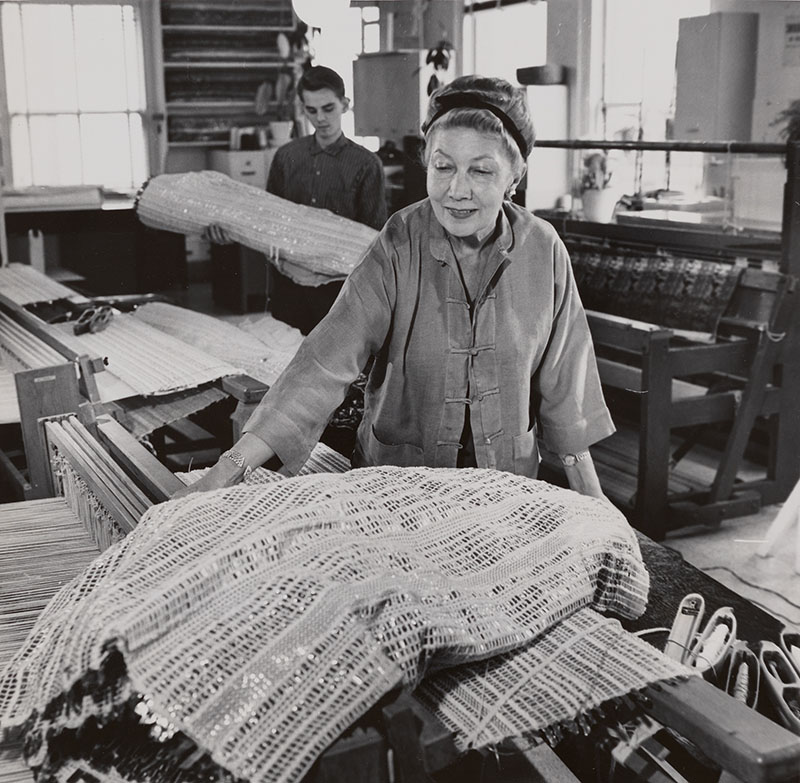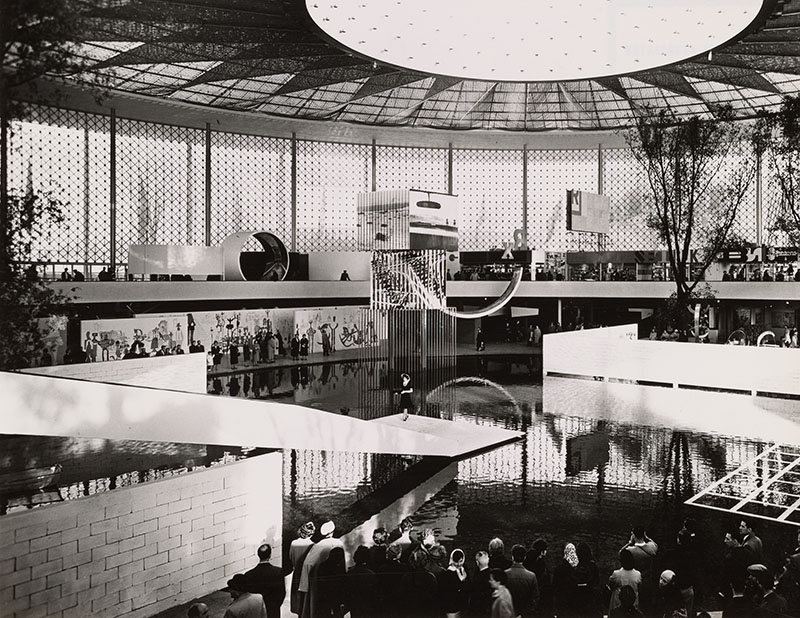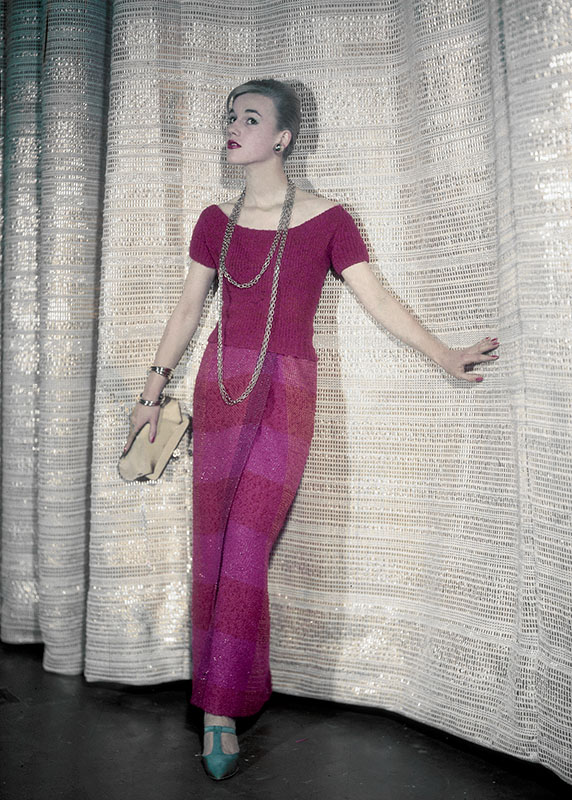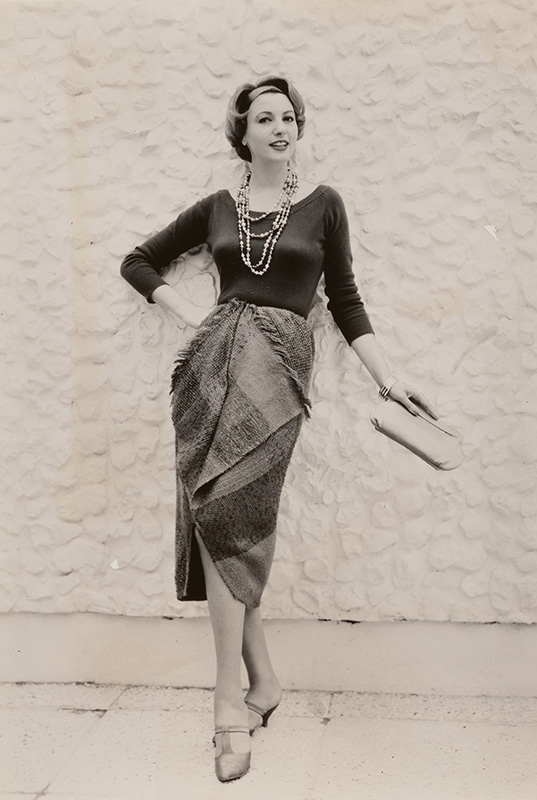Argonaut: Dorothy Liebes and the Brussels Universal Exposition
Click on images to enlarge them and view captions.
by Susan Brown and Alexa Griffith Winton
The groundbreaking exhibition A Dark, A Light, A Bright: The Designs of Dorothy Liebes opens this summer at Cooper Hewitt, Smithsonian Design Museum, shining a long-awaited spotlight on the legendary textile artist.
In 1958, Dorothy Liebes was at the peak of her considerable influence. Her handwoven fabrics could be seen in glamorous interiors across the country, from the Persian Room at the Plaza Hotel in New York to the San Francisco Stock Exchange. As a stylist and colorist, she had earned lucrative consulting contracts with firms like DuPont and Dobeckmun, makers of Lurex metallic yarns. With at least three world’s fairs already under her belt and innumerable large-scale public commissions, she was a natural choice to contribute her talents to the creation of the United States Pavilion at the Brussels Universal Exposition—Expo ’58.
Visitors to the pavilion were greeted by The Americans, an eight-part mural by artist Saul Steinberg placed in the foyer of the building (figure 1). The displays were conceived by the polymath architect, designer, author, and curator Bernard Rudofsky with Peter G. Harnden Associates and featured an eclectic range of objects ranging from a giant slab of a California redwood tree to a 480-page copy of the New York Times, and experiences like a color television production studio and the Music Room, which showcased high-fidelity audio equipment and 1,000 records by American recording artists. Entitled The Face of America, the exhibit was intended to reflect the American way of life, as filtered through the soft diplomacy of the world’s fair environment.
World’s fairs provided a platform through which countries communicated idealized snippets of national character via goods, new technologies, performances, and other promotional activities. With the beginning of the Cold War, cultural production—including design—became a locus of U.S. soft diplomacy, with the State Department actively promoting American Modernist designs and abstract expressionist art as emblems of freedom and prosperity in the Cold War era. As such, Liebes’s participation in the fair, and the presence of her textiles in the pavilion, emphasized her stature and influence as one of the foremost experts and representatives of American design.
The pavilion itself was designed by architect Edward Durrell Stone. The circular building—340 feet in diameter—was noted for its tensioned roof, supported by what was described as a bicycle wheel. The rim was held up by a colonnade of slender bronze-colored steel columns, the spokes supported a translucent plastic roofing material, and the hub—a cylindrical drum—was open to the sky. The open space was clear of any vertical supports and featured a willow tree and pond at its center (figure 2).
The perimeter curtain wall was fully glazed, flooding the interior with natural light during the day. At night, the building’s bright illumination shone like a beacon in the Square of Nations, located adjacent to the pavilion of the United States’ nemesis, the USSR. The light was filtered through a “glorious gold fabric hung in festoons”—a power-loomed nylon casement fabric designed by Liebes.1 The fabric was woven by Kandell Inc. with a silver and gold strié Lurex. Variegated or multicolor yarns were one of Liebes’s innovations while serving as color stylist for Lurex from 1946–61. Extraordinarily skilled at cross-promotion, Liebes used this prestigious commission not only to promote her own studio, but to spotlight Lurex, the brand she had been hired to represent.
Even more dramatic was the stage curtain Liebes designed for the pavilion’s 1,100-seat Theatre for the Performing Arts (figure 3), adjacent to the pavilion. In keeping with Stone’s design, which incorporated both classical and futuristic elements, and his established gold and white color palette, Liebes created a simple, plain-woven fabric with a white cotton warp offset by a profusion of gold metallics in the weft: five forms of Lurex braids, cords, and soutache, whose varied widths and profiles reflected and refracted light in myriad ways (figure 4). She titled the design Argonaut, perhaps a playful nod to both the gold yarns in the drape and crew of the mythical Greek ship Argo in search of the golden fleece. The word astronaut debuted in 1958, and she might have intended to invoke the dawning space age with the title as well. The 74-foot-wide stage required 22 panels, each nine yards long and 54 inches wide. In a feature article about the project in Handweaver & Craftsman, the accompanying photographs show the fabric in progress on at least three looms (figure 5). The studio logged over 1,200 hours weaving the glistening golden curtain, which incorporated 140 pounds of Lurex donated by Dobeckmun.2
Liebes frequently combined hand- and power-loomed fabrics in a single commission to achieve the maximum impact. The glittering stage curtain attracted the attention of the design press, and the power-loomed casement was effective, durable, budget-relieving, and was available for sale to the public under the name World’s Fair Casement. Her strategy was successful: the creation of Argonaut was featured in numerous magazine and newspaper articles, as well as in trade publications like Interiors and American Textile Reporter (figure 6).3
Liebes’s work was also on display in the fashion show that was the centerpiece of the Pavilion. A runway ending at a small island in the pond was the site of a daily parade of American fashions (figure 7). The fashion show—organized by Vogue—was notably democratic, showcasing ready-to-wear garments from over 60 clothing firms across the country at a wide range of price points. “These are the slice-of-life clothes,” the magazine wrote in its preview of the fair. “There’s the super-wife dress, for instance, that might walk the children to school or cruise the local A&P or Grand Union supermarket. There are dresses for parties, blue jeans for the country, a dress for golf, suits for swimming, pants for being at home…They’re the American look—on the record.”4 The show was a hit. As one reporter noted, European fashion shows were accessible only to the elite clients of haute couture designers.5 The fair may also have been many Europeans’ first exposure to the eminently wearable fashions of American women designers like Claire McCardell, Pauline Trigere, Clare Potter, and Bonnie Cashin.
Liebes and Cashin were close friends and collaborators, linked by a love of vibrant and sophisticated color palettes and a commitment to functional clothing for busy women. Cashin’s 1958 Skirtings Collection, which featured handwoven fabrics by Liebes, was shown at the exposition. One photograph captures a model wearing the casually elegant silhouette in deep bands of clashing pink and red wool bouclé, posed against Liebes’s stage curtain (figure 8). Another skirt from the collection, in an oversized blue and green check with a cascading fringe down the front, was photographed in the Argentine pavilion. Burlesque legend Gypsy Rose Lee wore an identical skirt to Stone’s birthday party in 1959, where the cake was decorated with a replica of his US Pavilion (figure 9).6
Although there is extensive correspondence in the Dorothy Liebes Papers at the Archives of American Art regarding the return of the curtain after the fair, it is unclear if it was ever returned. In fact, very little remains of Liebes’s commissions for public spaces, possibly due to the damaging fire-retardant chemicals that were used in Mid-Century fabrics. Although Lurex, which is coated with a plastic film, proved nearly impossible to fire-proof, Liebes discovered through experimentation that in its braided forms, enough chemical would lodge in the folds of the yarns to allow the material to pass flame-resistance tests. The chemicals led to the premature degradation of many textiles, including Marianne Richter’s stage curtain for the United Nations Economic and Social Council Chamber and Sheila Hicks’s embroidered panels for the Ford Foundation. The large panels of Liebes’s work held in museum collections today are largely show panels that were displayed in her own studio or showroom, or made for one of the many exhibitions of her work during her lifetime.
The Brussels Universal Exposition demonstrated Liebes’s ample powers as a designer, networker, brand ambassador, textile diplomat, and design authority. She was a trusted resource for the high-stakes commission, and, through her industry connections to Dobeckmun and Kandell, she was able to deliver an exceptional design, sympathetic to the pavilion’s architecture and echoing its golden surfaces, within budget. In turn, she garnered significant media attention for her clients. Most importantly, she kept American textiles and materials at the center of an international display of innovation and modernity.
- F. Charles Thum, “Architectural Metal at the Brussels Fair,” Metal Progress (January 1959) vol. 75 iss. 1, 71-72.
- “Dorothy Liebes Designs Fabrics for U.S. Theater at the Brussels World’s Fair,” Handweaver & Craftsman (Spring 1958) 26.
- List of press placements circulated by Ellen Grotto, Home Furnishings Publicity Director, The Dobeckmun Company, Dorothy Liebes Papers, Archives of American Art, Smithsonian Institution, Series 5 Box 6 Folder 39.
- “Fashion: Belgium 1958—the Land, the New World’s Fair, and Us-an on-the-Spot Report.” Vogue, April 15, 1958.
- Jane Fisk McCollough, “Impressions of Expo ’58,” Industrial Design 7 (July 1958), 45.
- Eugenia Sheppard, “How to Vacuum in Style,” New York Herald Tribune, March 11, 1959.
Susan Brown is an Acting Head of Textiles and Alexa Griffith Winton is Manager of Content + Curriculum at Cooper-Hewitt, Smithsonian Design Museum. They co-curated the museum’s exhibition A Dark, A Light, A Bright: The Designs of Dorothy Liebes, on view from July 7, 2023, through February 4, 2024.
A print version of this article was published in The Magazine of the Decorative Arts Trust, one of our most popular member benefits. Join today!



